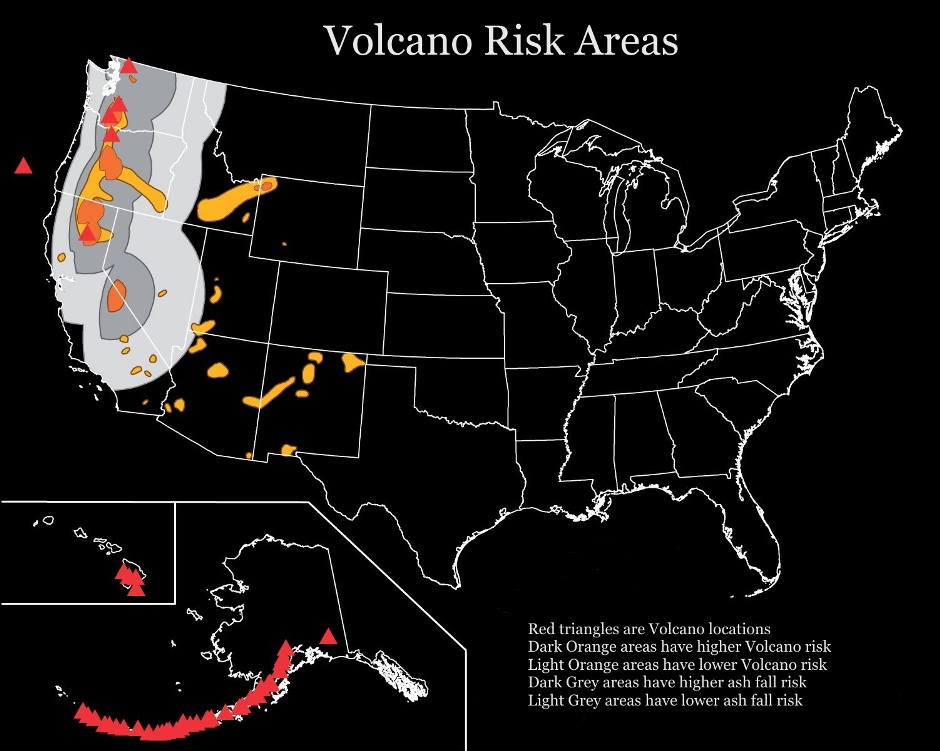A volcano is a mountain that opens downward to a reservoir of molten rock below the surface of the earth.When pressure from gases within the molten rock becomes too great, an eruption occurs. Eruptions can be quiet or explosive. There may be lava flows, flattened landscapes, poisonous gases, and flying rock and ash that can sometimes travel hundreds of miles downwind. Active volcanoes in the U.S. are found mainly in Hawaii, Alaska and the Pacific Northwest. The danger area around a volcano covers approximately a 20-mile radius however some danger may exist 100 miles or more from a volcano.
Because of their intense heat, lava flows are great fire hazards. Lava flows destroy everything in their path, but most move slowly enough that people can move out of the way.
Fresh volcanic ash, made of pulverized rock, can be abrasive, acidic, gritty, gassy and odorous. While not immediately dangerous to most adults, the acidic gas and ash can cause lung damage to small infants, to older adults and to those suffering from severe respiratory illnesses. Volcanic ash also can damage machinery, including engines and electrical equipment. Ash accumulations mixed with water become heavy and can collapse roofs. Volcanic ash can affect people hundreds of miles away from the cone of a volcano.
Sideways directed volcanic explosions, known as "lateral blasts," can shoot large pieces of rock at very high speeds for several miles. These explosions can kill by impact, burial or heat. They have been known to knock down entire forests.
Terminology
- Ashfall - Volcanic ash that has fallen through the air from an eruption cloud. A deposit so formed is usually well sorted and layered.
- Lahar - A flowing mixture of water and rock debris, sometimes referred to as a debris flow (originating at a volcano) or mudflow.
- Pyroclastic flow - A hot 570-1470 degrees F, dry, fast-moving 20 to more than 200 miles per hour and high-density mixture of ash, pumice, rock fragments, and gas formed during explosive eruptions or from the collapse of a lava dome. Moves away from a volcano at high speeds.
- VEI Scale - Some scientists recently proposed the Volcanic Explosivity Index (VEI) to attempt to standardize the assignment of the relative size of an explosive eruption, using ejecta volume as well as the other criteria.
| VEI | Description | Plume Height | Classification | How often | Example |
| 0 | non-explosive | < 100 m | Hawaiian | daily | Kilauea |
| 1 | gentle | 100-1000 m | Haw/Strombolian | daily | Stromboli |
| 2 | explosive | 1-5 km | Strom/Vulcanian | weekly | Galeras, 1992 |
| 3 | severe | 3-15 km | Vulcanian | yearly | Ruiz, 1985 |
| 4 | cataclysmic | 10-25 km | Vulc/Plinian | 10's of years | Galunggung, 1982 |
| 5 | paroxysmal | >25 km | Plinian | 100's of years | St. Helens, 1980 |
| 6 | colossal | >25 km | Plin/Ultra-Plinian | 100's of years | Krakatau, 1883 |
| 7 | super-colossal | >25 km | Ultra-Plinian | 1000's of years | Tambora, 1815 |
| 8 | mega-colossal | >25 km | Ultra-Plinian | 1000's of years | Yellowstone, 2 Ma |

